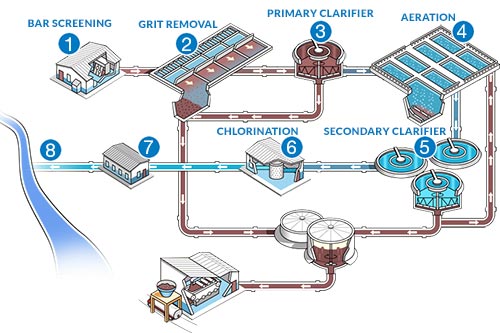Budget-Friendly and Eco-Friendly Wastewater Treatment Services Locally
Budget-Friendly and Eco-Friendly Wastewater Treatment Services Locally
Blog Article
Comprehending Wastewater Therapy Processes and Their Environmental Influence
The intricacies of wastewater therapy procedures play an essential duty in mitigating ecological difficulties connected with water pollution. Each stage, from preliminary to innovative therapies, is created to attend to details pollutants, ultimately securing both public health and wellness and water environments.
Introduction of Wastewater Treatment
Just how is wastewater changed right into a secure resource for the setting? Wastewater therapy is a crucial process made to get rid of impurities from utilized water, thus safeguarding public wellness and securing communities. This procedure starts with the collection of wastewater from residential, commercial, and commercial resources, which is after that guided to treatment facilities.
At these centers, different physical, chemical, and biological methods are employed to deal with the wastewater. Subsequently, organic treatments, such as triggered sludge processes, make use of microorganisms to damage down natural matter.
The treated effluent can be securely released into natural water bodies or recycled for irrigation and industrial purposes, promoting source preservation. Furthermore, the treatment process generates biosolids, which can be repurposed as plant foods or soil changes, even more enhancing sustainability.
Phases of Treatment Procedures
The wastewater treatment process normally includes 3 main phases: preliminary, primary, and second treatment. Each stage offers an unique role in decreasing the toxin load and making certain the effluent meets environmental standards before discharge.

The primary treatment stage focuses on the physical splitting up of put on hold solids from the wastewater. Via sedimentation, larger fragments clear up at the base of sedimentation storage tanks, developing sludge, while lighter materials, such as oils and greases, float to the surface and are skimmed. This procedure significantly minimizes the natural and inorganic load in the wastewater.
Second treatment is an organic procedure aimed at more lowering the concentration of organic issue. This stage is essential for achieving the required biochemical oxygen demand (BODY) reduction, eventually leading to cleaner effluent ready for discharge or further therapy.

Advanced Treatment Technologies
Adhering to the secondary therapy procedures, advanced therapy technologies play an essential role in more enhancing the high quality of dealt with wastewater. These innovations are made to remove recurring impurities that are not efficiently removed during key and secondary therapies, ensuring the effluent meets rigid regulatory requirements.
Amongst the extensively utilized sophisticated treatment approaches are membrane layer filtration, reverse osmosis, and advanced oxidation procedures. Membrane layer purification, including microfiltration and ultrafiltration, works in dividing great fragments, pathogens, and colloids from the water (Wastewater). Reverse osmosis uses semi-permeable membrane layers to get rid of liquified solids, causing premium water ideal for numerous applications
Advanced oxidation procedures (AOPs) employ solid oxidants to degrade organic pollutants, including pharmaceuticals and personal care products that are resistant to traditional treatment. These techniques boost the biodegradability of complex compounds, facilitating their removal.
Another significant technology is using biological nutrient elimination procedures, which specifically target nitrogen and phosphorus, stopping eutrophication in receiving water bodies. On the whole, sophisticated therapy innovations are crucial for accomplishing greater levels of purification, advertising water reuse, and guarding public wellness while resolving the obstacles linked with wastewater administration.
Environmental Benefits of Therapy
Many environmental benefits arise from reliable wastewater therapy processes that add to ecosystem health and sustainability. Largely, these procedures substantially lower the launch of go to website damaging pollutants right into all-natural water bodies, which helps maintain marine environments. By eliminating contaminants such as hefty steels, nutrients, and pathogens, dealt with wastewater alleviates the risk of waterborne conditions and promotes biodiversity in marine settings.
Furthermore, wastewater treatment centers typically employ innovative technologies that make it possible for water recycling and reuse. This method not only saves freshwater sources but additionally decreases the need on natural water products. Improved nutrient elimination from wastewater can likewise prevent eutrophication, a process that leads to algal flowers and succeeding oxygen exhaustion in water systems.
Additionally, efficient therapy processes can decrease greenhouse gas emissions, especially methane and laughing gas, which are typically launched during neglected wastewater decomposition. By recording and utilizing biogas from anaerobic digesters, facilities can convert waste into sustainable power, thus adding to a decrease in fossil fuel dependency.
Obstacles and Future Fads
While the environmental benefits of wastewater therapy are clear, numerous challenges continue that impede optimum outcomes in this area. One major concern is maturing infrastructure, which frequently causes inadequacies and increased operational expenses - Wastewater. Lots of therapy plants were designed decades back, and their abilities do not line up with modern-day needs, that include more stringent regulatory standards and higher volumes of wastewater due to urbanization

Looking in advance, there is a growing focus on resource recovery and round economic climate concepts within wastewater therapy. Advancements such as anaerobic digestion, which can generate biogas, and advanced purification innovations are gaining grip. These Visit Website methods not just enhance therapy efficiency but also advertise sustainability.
Eventually, addressing these obstacles requires cooperation among stakeholders, financial investment in technology, and a dedication to ongoing research. By accepting these trends, the wastewater treatment market can evolve to satisfy the needs of an altering environment and culture.
Final Thought
In conclusion, wastewater therapy procedures play an important duty in enhancing environmental top quality and public health. The multi-stage treatment structure, coupled with sophisticated modern technologies, effectively alleviates air pollution you can try this out and promotes sustainable water administration. By resolving residual pollutants and lessening vitamins and mineral runoff, these processes add to the conservation of marine communities and the reduction of greenhouse gas discharges. Proceeded advancements and adaptations in treatment techniques will be necessary for overcoming emerging difficulties and making sure the sustainability of natural deposits (Wastewater).
Report this page